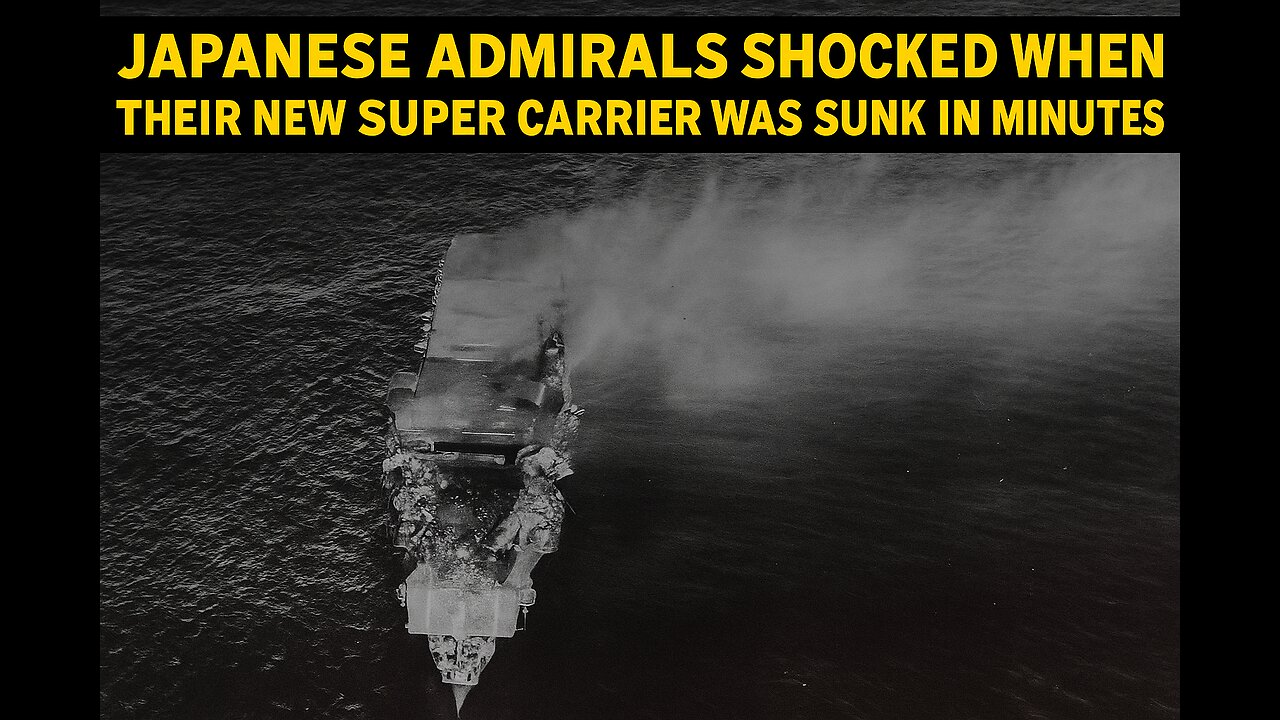Premium Only Content

Japanese Admirals Shocked When Their New Super Carrier Was Sunk in Minutes
November 29th, 1944. The waters south of Japan lie black and cold, the horizon invisible. Beneath the moonless sky, a monster moves — seventy thousand tons of steel gliding silently through the Pacific. The Shinano. At 872 feet, she’s the largest aircraft carrier the world has ever seen. A floating fortress that Japan believes cannot die. Beneath her, hidden in the deep, the USS Archerfish stalks her prey. Neither crew knows it yet, but within the next few hours, this encounter will carve itself into naval history. This is how the world’s largest carrier was sunk before she even fired a shot — and how silence, patience, and precision humbled pride built from steel. After Midway, Japan’s navy was crippled. Four carriers gone in a single day. To reclaim lost honor, the Imperial Navy dreamed of a new symbol: the Shinano. Born from the unfinished hull of a Yamato-class battleship, she was rebuilt in secret as a colossal support carrier — a ship meant to carry planes, spare parts, and fuel for others. Her armor was thicker than anything afloat, her bulkheads designed to shrug off torpedoes. Engineers boasted she could take twelve hits and still fight. To Japan, she wasn’t just a ship. She was redemption — proof that the empire could still outbuild and outlast. But arrogance had been welded into every beam. By late 1944, Japan’s empire was collapsing. American bombers rained on the home islands, oil was running dry, and every fleet movement came at a cost. Yet Shinano was treated as untouchable, a vessel that could not fail. In the shipyards of Yokosuka, work went on day and night under blackout. The paint was still wet when her launch date was set. Her crew knew the truth — she wasn’t ready. Pipes unsealed. Bulkheads incomplete. Watertight doors untested. But Tokyo’s order was final. She must sail before bombers found her. So, on the evening of November 28th, the Shinano slipped out of Yokosuka under cover of darkness. Destination: Kure Naval Base, where she’d be finished and armed. She carried only a skeleton crew — a third trained sailors, the rest yard workers and mechanics still bolting equipment as she moved. Her escorts — three destroyers, Isokaze, Hamakaze, and Yukikaze — formed a loose screen around her, unaware that American submarines prowled these same waters. On paper, Shinano could survive multiple torpedoes. In reality, she could barely handle a sharp turn. The ocean that once belonged to Japan was now American hunting ground. That same night, Archerfish cruised south of Tokyo Bay. Commander Joseph Enright stood in the control room, calm but restless. He’d once let a target escape through caution — a mistake that haunted his record. Tonight, he wanted redemption. At 8 p.m., radar detected a faint blip — large, fast, moving erratically. Not a convoy. Not a freighter. Enright brought the sub to periscope depth. Through the haze, he saw a black silhouette unlike anything he’d ever seen — massive, moving at twenty knots, flanked by destroyers. He radioed headquarters. No response. He made his choice. “Shadow her. Stay quiet. Wait.” For six hours, the submarine crept beneath the surface, mimicking her turns, matching her speed. Every few minutes, Enright lifted the periscope for a glimpse — just enough to confirm she was still there.
-
 LIVE
LIVE
StoneMountain64
4 hours agoBlack Ops 7 Dead Ops ARCADE Gameplay #Cod_Partner
73 watching -
 34:49
34:49
Stephen Gardner
2 hours ago🔥Trump DROPS Secret Plan – Democrats Left SPEECHLESS!
9.58K27 -
 LIVE
LIVE
The Rabble Wrangler
14 hours agoNew Eastwood Map | The Best in the West Dominates the Battlefield
47 watching -
 1:10:42
1:10:42
vivafrei
3 hours agoThomas Crooks Exposé is a BOMBSHELL! Epstein Drama Continues! Alexis Wilkins Streisand Effect & More
113K60 -
 1:41:04
1:41:04
The Quartering
4 hours agoEpstein Files Takes Its First Scalp, MTG Unleashes, Kash Patel Blasted, Internet Outage & More
117K85 -
 24:53
24:53
Jasmin Laine
2 hours ago“NO ONE BELIEVES YOU”—Carney Gets HUMILIATED in BRUTAL Showdown
4.36K10 -
 LIVE
LIVE
LFA TV
20 hours agoLIVE & BREAKING NEWS! | TUESDAY 11/18/25
1,257 watching -
 LIVE
LIVE
freecastle
7 hours agoTAKE UP YOUR CROSS- The fear of the LORD begins knowledge; Fools despise WISDOM and INSTRUCTION.
144 watching -
 5:16
5:16
Buddy Brown
4 hours ago $2.07 earnedWatch INSANE Video of Woman Denied a TINY HOME on 37 Acres! | Buddy Brown
16.1K6 -
 59:19
59:19
Professor Nez
4 hours ago🔥 Trump TORCHES ABC Reporter for Disrespecting Saudi Crown Prince Mohammed bin Salman! (WOW!)
30.2K24